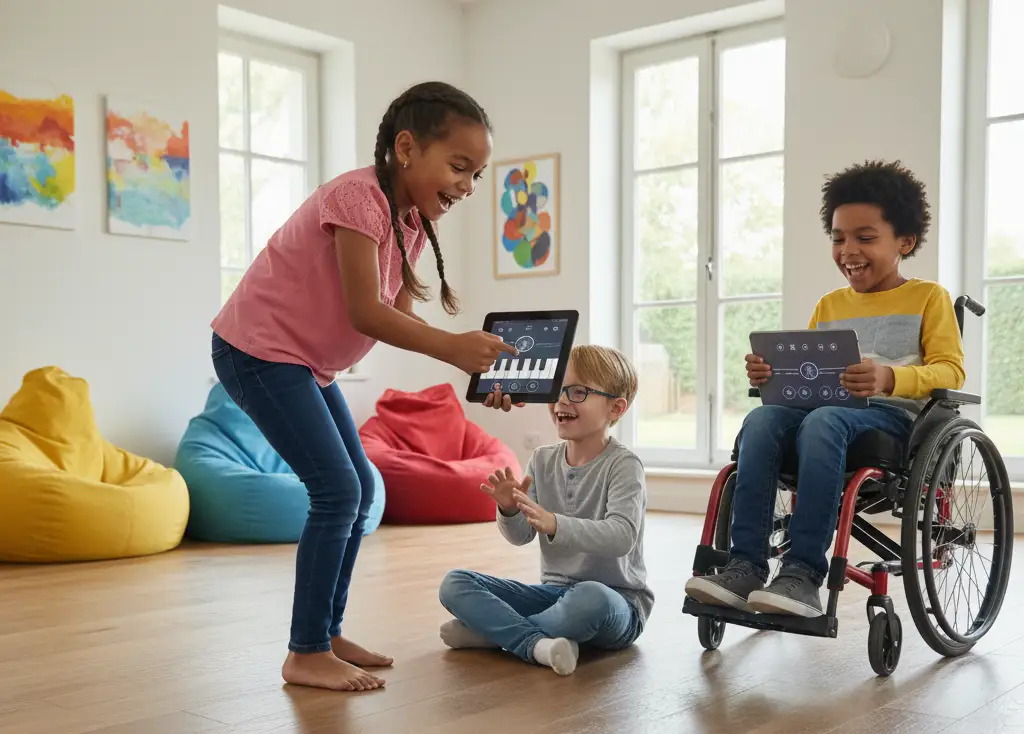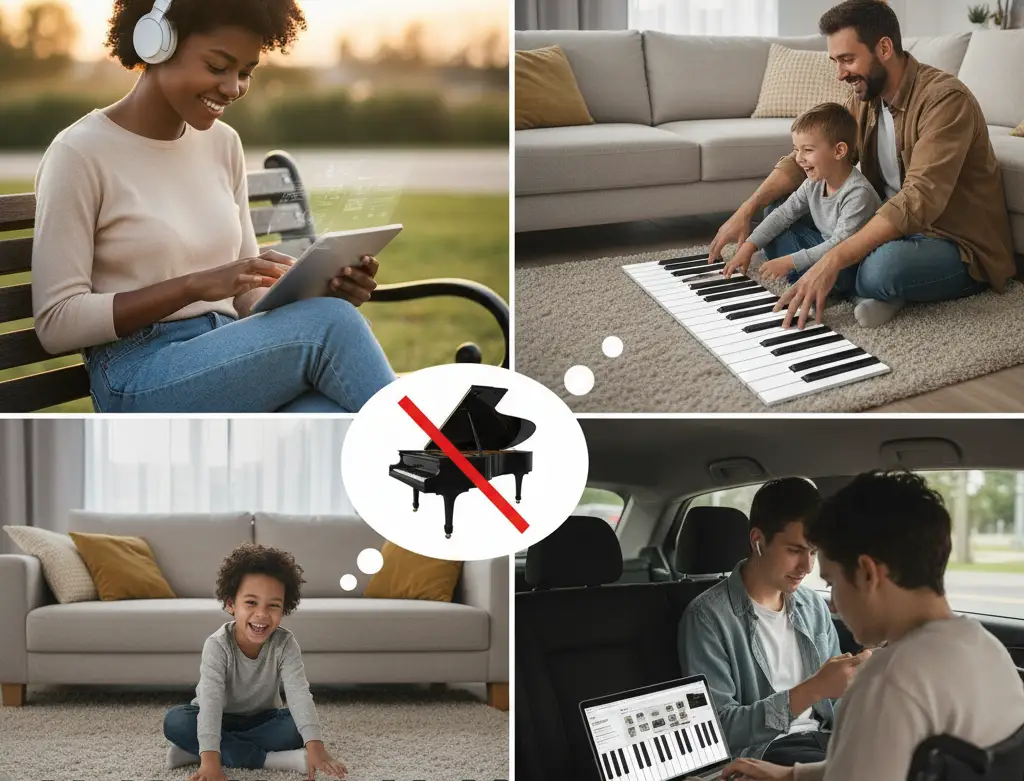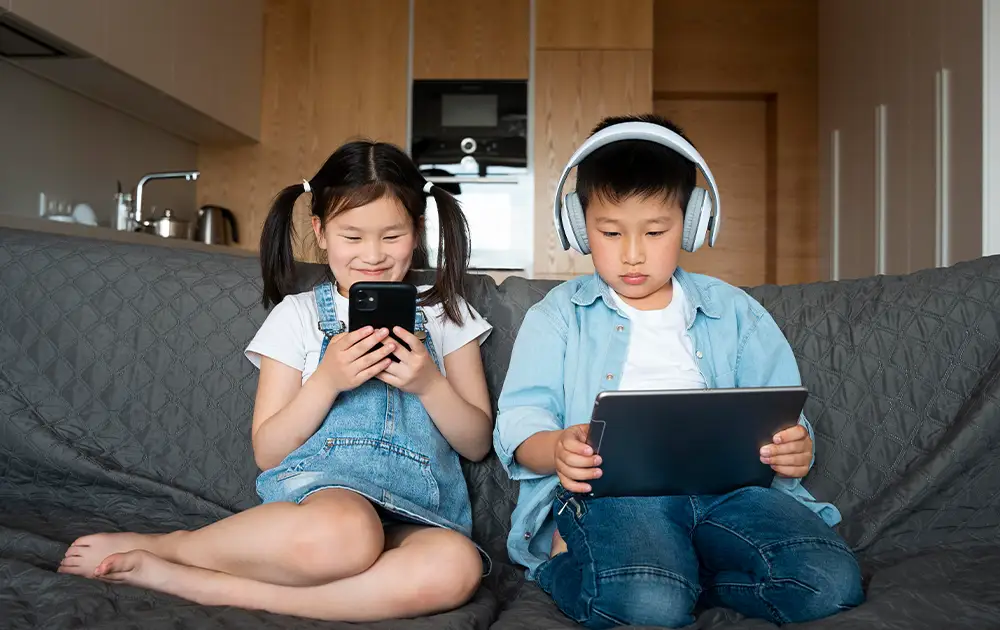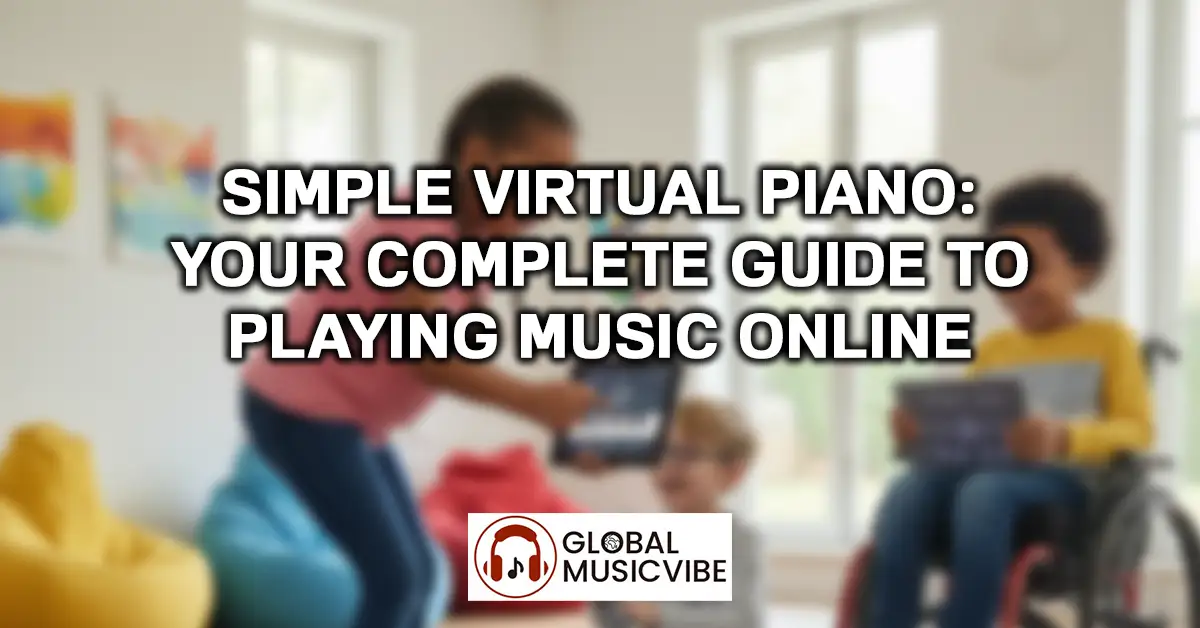A simple virtual piano is revolutionizing how people learn, practice, and enjoy music in the digital age. Whether you’re a complete beginner taking your first steps into the world of music or an experienced musician looking for a convenient practice tool, virtual pianos offer an accessible and versatile solution that fits right in your web browser.
What Is a Simple Virtual Piano?
A simple virtual piano is an online or web-based application that simulates a real piano keyboard on your computer, tablet, or smartphone screen. Unlike physical pianos that require significant space and investment, virtual pianos provide immediate access to playable keys that produce realistic piano sounds through your device’s speakers or headphones.
These digital instruments use Web Audio API technology to generate authentic piano tones when you click or tap the on-screen keys. Most simple virtual pianos feature a standard keyboard layout with white and black keys representing different musical notes, allowing users to play melodies, chords, and complete songs without owning a physical instrument.
The beauty of a simple virtual piano lies in its accessibility. You don’t need to download software, create accounts, or pay subscription fees. Simply open your web browser, navigate to a virtual piano website, and start playing immediately. This instant access makes virtual pianos particularly valuable for students, teachers, casual music enthusiasts, and anyone curious about learning piano basics.

Key Features of Modern Virtual Pianos
Today’s virtual pianos come equipped with impressive features that enhance the playing experience. Most platforms offer keyboard mapping, which allows you to use your computer keyboard as piano keys. For example, the keys A through K might correspond to a full octave of notes, making it easy to play without touching your screen.
Visual feedback is another essential feature. When you press a key, it typically lights up or changes color, providing immediate confirmation of your action. This visual element helps beginners understand which keys they’re pressing and aids in developing muscle memory for different note positions.
Sound quality has improved dramatically in recent years. Modern virtual pianos use high-quality audio samples or sophisticated sound synthesis to produce realistic piano tones. Some platforms even offer different piano types, including grand pianos, upright pianos, and electric keyboards, each with distinct tonal characteristics.
Many virtual pianos also include recording capabilities, allowing you to capture your performances and play them back. This feature is invaluable for tracking your progress, composing original music, or simply preserving a beautiful melody you’ve created. Some advanced versions even support MIDI input, enabling you to connect a physical MIDI keyboard for a more authentic playing experience.
Benefits of Using a Simple Virtual Piano
The advantages of virtual pianos extend far beyond convenience. For beginners, these instruments eliminate the intimidation factor often associated with learning music. You can experiment freely without worrying about disturbing neighbors or family members, as you control the volume completely. This freedom encourages exploration and creativity without external pressure.
Cost savings represent another significant benefit. Traditional acoustic pianos can cost thousands of dollars, plus additional expenses for tuning, maintenance, and climate control. Digital pianos, while more affordable, still require substantial investment. A simple virtual piano costs nothing yet provides a legitimate platform for learning music theory, practicing rhythm, and developing finger coordination.
Portability is a game-changer for musicians. Whether you’re traveling, at work during lunch break, or visiting friends, your virtual piano is always accessible through any device with internet connection. This constant availability means you can practice whenever inspiration strikes or when you have a few spare minutes.
For music educators, virtual pianos serve as excellent teaching tools. Teachers can share links with students for homework assignments, demonstrate concepts during video calls, or create interactive lessons that students can follow along with in real-time. The visual nature of on-screen keyboards also helps students understand music theory concepts like intervals, scales, and chord structures.

Learning Music Theory With Virtual Pianos
Understanding music theory becomes more intuitive when you can immediately hear the results of theoretical concepts. A simple virtual piano allows you to experiment with scales, watching and hearing how different note patterns create major, minor, pentatonic, and other scale types. You can play intervals to understand the distance between notes and how these relationships create harmony or dissonance.
Chord construction becomes clearer when you can see the keys that form different chords. By pressing three or four keys simultaneously, you can hear major chords, minor chords, diminished chords, and more complex harmonic structures. This hands-on approach to learning theory accelerates comprehension compared to studying from books alone.
Virtual pianos also help with ear training. You can play a note and try to sing it back, or play a melody and attempt to recreate it by ear. This practice develops relative pitch, the ability to identify notes based on their relationship to other notes, which is fundamental to musical proficiency.
Practicing Songs and Melodies
One of the most enjoyable aspects of using a simple virtual piano is learning to play your favorite songs. Start with simple melodies that use only a few notes, such as “Mary Had a Little Lamb” or “Twinkle Twinkle Little Star.” These beginner-friendly pieces help you develop basic finger positioning and rhythm while providing immediate gratification.
As you progress, challenge yourself with more complex pieces. Many websites offer tutorials and sheet music specifically designed for virtual piano practice. You can follow along at your own pace, pausing and replaying difficult sections until you master them. This self-directed learning approach allows you to focus on areas that need improvement without the pressure of keeping up with a class or instructor.
For those interested in contemporary music, virtual pianos are perfect for learning popular songs. Whether you’re trying to recreate melodies from your favorite artists or figuring out chord progressions, having instant access to a keyboard makes the learning process faster and more engaging. You can even explore different genres to broaden your musical horizons, from classical compositions to modern pop hits.
Creative Composition and Improvisation
Beyond learning existing music, a simple virtual piano serves as an excellent tool for creating original compositions. The low-pressure environment encourages experimentation, allowing you to try different note combinations without fear of making mistakes. You might stumble upon a beautiful chord progression or catchy melody that becomes the foundation for a complete song.
Improvisation skills develop naturally when you have constant access to a virtual piano. Set aside time to freely explore the keyboard, playing whatever feels right in the moment. This practice enhances your musical intuition and helps you understand how different notes work together. Over time, you’ll develop a personal style and the ability to express emotions through music.
Many musicians use virtual pianos for songwriting, creating melodies and harmonies that they later record with full instrumentation. The immediate feedback and easy experimentation make virtual pianos ideal brainstorming tools for musical ideas. You can quickly test different variations of a melody or try alternative chord progressions until you find the perfect combination.

Connecting Virtual Piano Practice to Real Instruments
While a simple virtual piano is a valuable tool on its own, it also serves as an excellent stepping stone to playing physical instruments. The skills you develop—finger positioning, rhythm, music reading, and theoretical understanding—transfer directly to acoustic and digital pianos. Many successful musicians began their journey with virtual or toy keyboards before advancing to professional instruments.
If you’re considering purchasing a physical piano or keyboard, virtual piano experience helps you make informed decisions. You’ll understand which features matter most to you, whether you prefer weighted keys, specific sound characteristics, or particular size requirements. This knowledge can save you money and ensure you select an instrument that matches your playing style and goals.
For those who already own physical instruments, virtual pianos complement your practice routine. They’re perfect for quick warm-ups, theory review, or late-night practice sessions when you can’t use your acoustic instrument. The combination of virtual and physical practice creates a well-rounded musical education.
Enhancing Your Listening Experience
Developing piano skills through virtual practice enhances your appreciation for recorded music. When you understand how melodies and harmonies work, listening to songs becomes a more enriching experience. You’ll notice subtle details in arrangements, recognize chord progressions, and appreciate the technical skill required for complex performances.
This deeper understanding applies whether you’re exploring new music through various songs or evaluating audio quality when you compare headphones for your listening setup. The musical knowledge gained from virtual piano practice informs your choices about audio equipment, as you’ll better understand what frequencies and tonal qualities to prioritize.
Technical Considerations and Tips
For the best virtual piano experience, ensure your device meets basic technical requirements. A stable internet connection prevents lag between key presses and sound output. Modern web browsers like Chrome, Firefox, Safari, or Edge all support the Web Audio API technology that powers virtual pianos.
Audio quality significantly impacts your playing experience. While built-in device speakers work adequately, connecting external speakers or headphones dramatically improves sound quality. If you compare earbuds for music practice, look for models with good frequency response in the mid-to-lower ranges where piano fundamentals reside.
Keyboard mapping varies between virtual piano platforms, so spend a few minutes familiarizing yourself with which computer keys correspond to which piano notes. Some platforms allow customization, enabling you to create a layout that feels intuitive for your playing style.
Browser settings can affect performance. Ensure your browser has permission to play audio automatically, as some security settings block sound by default. If you experience audio issues, check your browser’s site permissions and grant necessary access to the virtual piano website.

Accessibility and Inclusivity in Music
Virtual pianos make music accessible to people who might otherwise never have the opportunity to learn an instrument. Those with physical disabilities can often interact with virtual pianos more easily than traditional instruments, especially when using adaptive technologies. The visual interface accommodates various learning styles, benefiting visual learners who struggle with traditional music notation.
Geographic and economic barriers to music education diminish when quality instruments are freely available online. Students in remote areas without access to music teachers or instrument stores can begin their musical journey with a simple virtual piano. This democratization of music education creates opportunities for talented individuals who might otherwise never discover their musical abilities.
Language barriers also become less significant, as music itself is a universal language. Even if you don’t speak the same language as a tutorial creator, you can often follow along by watching which keys are pressed and listening to the resulting sounds.
Future of Virtual Musical Instruments
Technology continues advancing, promising even more impressive virtual instruments in the future. Virtual reality and augmented reality technologies may soon create immersive musical experiences where you interact with three-dimensional instruments in virtual spaces. Artificial intelligence might provide personalized learning paths, analyzing your playing and suggesting customized exercises to improve specific skills.
Cloud-based collaboration features could enable musicians worldwide to play together in real-time, creating virtual orchestras and bands that transcend physical boundaries. Enhanced haptic feedback might eventually provide tactile sensations that simulate the feel of pressing real piano keys, further closing the gap between virtual and physical instruments.
Machine learning algorithms could analyze your playing style and automatically adjust difficulty levels, ensuring you’re always challenged appropriately without becoming frustrated. These intelligent systems might even compose custom practice pieces tailored to your current skill level and musical preferences.
Frequently Asked Questions
Can I learn real piano skills from a simple virtual piano?
Yes, you can develop fundamental piano skills using a virtual piano. You’ll learn music theory, note relationships, rhythm, chord structures, and basic finger positioning. However, virtual pianos lack the weighted keys and touch sensitivity of acoustic pianos, so transitioning to a physical instrument requires some adjustment. Virtual pianos are excellent for beginners and serve as convenient practice tools for experienced musicians.
Do I need special equipment to use a virtual piano?
No special equipment is required. Any device with a web browser and speakers or headphones will work. Your computer keyboard serves as the piano keys, though you can also use a touchscreen to tap keys directly. For enhanced experience, consider using external speakers or quality headphones for better sound quality. Some advanced users connect MIDI keyboards to virtual piano software for a more authentic playing feel.
Is a virtual piano suitable for professional musicians?
While professional musicians typically prefer physical instruments for serious practice and performance, virtual pianos serve valuable supplementary purposes. They’re convenient for quick practice sessions, teaching students remotely, composing on-the-go, or demonstrating concepts. Many professionals use virtual instruments for songwriting and initial composition before recording with acoustic instruments.
How does a virtual piano compare to piano learning apps?
Virtual pianos and piano learning apps serve different but complementary purposes. Virtual pianos provide immediate access to playable keyboards without downloads or accounts, focusing on free-play and exploration. Piano learning apps typically offer structured lessons, progress tracking, and gamified learning experiences but often require downloads and subscriptions. Combining both approaches creates a comprehensive learning experience.
Can children use virtual pianos safely?
Virtual pianos are safe and appropriate for children. They provide a risk-free environment for exploring music without concerns about broken strings, pinched fingers, or damaged instruments. Parents should supervise internet usage and ensure children access reputable virtual piano websites. The visual and interactive nature of virtual pianos often engages children more effectively than traditional learning methods.

